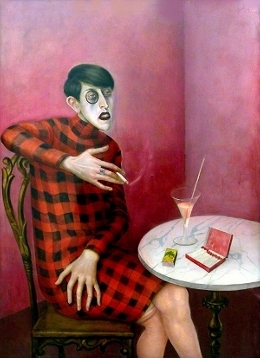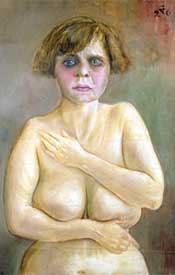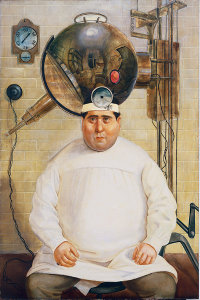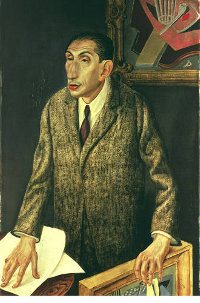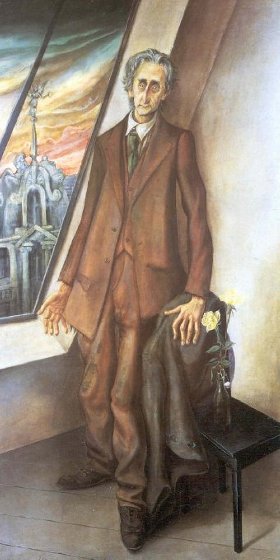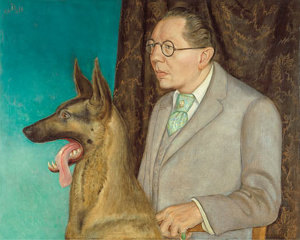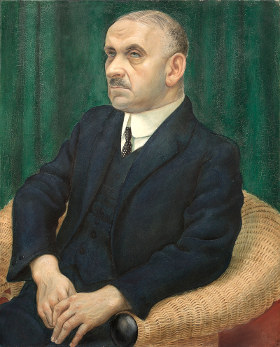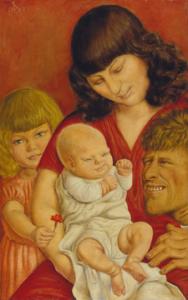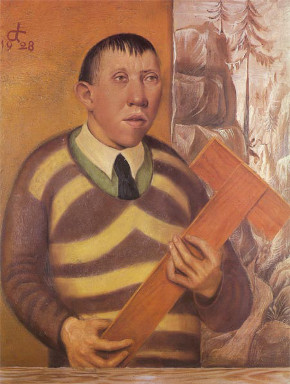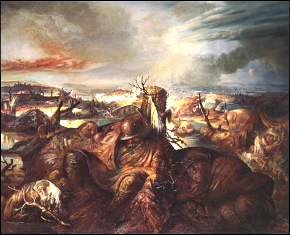Portrait of the Journalist Sylvia von Harden
Year: 1926
Description: She walked in one direction and he in the other. Dix stopped in his tracks. "I must paint you, I simply must! You represent an entire epoch." She was amused. "You want to paint my lacklustre eyes, my ornate ears, my long nose, my thin lips. You want to paint my short legs, my big feet - things that can only frighten people and delight no one?" To Dix, her depiction was perfect. The portrait would represent a generation concerned not with the outward beauty of a woman but her psychological condition.
Provenance: Staatsgalerie, Stuttgart
Semi-Nude
Year: 1926
Description: Maureen Mullarkey described this work as an "unsettling variation on the effect of postwar deprivation on the socially marginal, particularly women of the red light district." The portrait, she says, "presents a blowzy hermaphroditic figure; a powdered male head sets on a shambling female form." Her heavy make-up attempts to mask the truth her body reveals. Life is hard on the down trodden.
Provenance: Ronald S. Lauder Collection
Portrait of Dr. Mayer-Hermann
Year: 1926
Description: This Dr. Mayer-Hermann and his portrait both emigrated to New York City. Six years after he sat for Dix, the painting was donated to the Museum of Modern Art. Two years later, Mayer-Hermann emigrated to New York where he established a successful ear, nose and throat practice. It's said that he enjoyed visiting "himself" on display.
Provenance: Museum of Modern Art
The Art Dealer Alfred Flechtheim
Year: 1926
Description: Alfred Flechtheim entered the art world as a collector of Far Eastern art. In 1910, he married the daughter of a wealthy Dortmund merchant. This union helped provide him with the means to open a gallery in 1913. On the eve of the First World War, Flechtheim's gallery was filled with works by the French avant-garde. He had a reputation as Francophile with a particular affection for Cubism. In Düsseldorf, local artists unfairly suggested that he had turned his back on German art. In this unflattering, uncommissioned work by Dix, he is surrounded by Cubist works. He clutches one in one hand and bills in another. To Dix, he's little more than a salesman in a cheap suit, hawking foreign merchandise for the local Bourgeoisie.
Provenance: Staatliche Museen zu Berlin
Der Dichter Iwar von Lücken
Year: 1926
Description: Iwar von Lücken was the last in the line of Baltic aristocrats. He was born into privilege and died in poverty under unknown circumstances. His aesthetics were of the avant garde while his family was entrenched in tradition, a difference that cast von Lücken as a black sheep.
Iwar von Lücken was a poet whose work is reduced to a thin single volume. He'd be a literary unknown if not for this portrait. Dix provided post mortem fame that he was unable to obtain with a pen.
To Otto Dix, von Lücken was a sorry figure and that's probably what drew him to the artist. Dix accentuates his poverty -- the poet's complexion is gaunt and his suit was cut before he grew thin. The poet slouches and needs a chair rail for support. Peter de Mendelssohn saw him Berlin soon after he posed for this portrait. The poet with the enobling "von" was seen begging for coins in a cafe.
Provenance: Berlinische Galerie
Hugo Erfurth With His Dog Ajax
Year: 1926
Description: This is an oil on canvas portrait of the photographer Hugo Erfurth. There are very few animals in the Dix catalog but the artist painted Erfurth's faithful German Shepard on several occasions.
Erfurth was 15 years his senior and an established photographer when the pair met. Initial intimidation may have affected Dix's treatment of his subject. His early Erfurth portraits lack his characteristic tendency to accentuate the subject's worst traits. By 1926, Dix appears to possess the confidence to give Erfurth the full treatment. The photographer's rotund face, slumped shoulders and failing eyesight are featured prominently in this painting.
Provenance: Museo Thyssen-Bornemisza
Portrait of Josef May
Bildnis Josef May
Year: 1926
Description: Josef May was a grain merchant with the firm J. Grunberg in Düsseldorf during the time he sat for this portrait. He was related by marriage to Hugo Simms who sat for Dix in 1925.
Dix painted May with the same dry and aloof objectivity that characterized the best of his Neue Sachlichkeit portraits. In 1926 he was, after all, at the top of his game. It was a time in which he completed Sylvia von Harden, Anita Berber and Albert Fletcheim, works widely regarded as some of his best portraits.
While this painting may be reminscent of Renaissance style, its hallmarks differ thanks to some psychological tension. The sitter is both chiseled like a statue yet full of energy. May's lips are taut and his hands are gnarled. His eyes -- which were meant to work in unison -- seem to fight one another for the brain's attention.
Provenance: Public Museum
- Cleveland Museum of Art - present
- J. H. Wade Fund - 1985
- Fischer Fine Arts, London - 1985
- Ghitta Caiserman-Roth, Montreal
- Hugo Simons, Montreal - 1936
- Josef May, Düsseldorf - 1926
The Artist's Family
Year: 1927
Description: This depiction of the artist's family was completed in 1927 after the birth of Otto and Martha's second child, Ursus. Four year old Nelly hides behind her mother and offers a flower to the infant.
This painting is noteworthy for its self-deprecation. While he was quick accentuate the worst features in others, Dix generally portrayed himself in a flattering manner. Here young Ursus has reduced Dix to a blithering idiot. He coos and makes faces at the boy.
Provenance: Städel Museum, Frankfurt am Main
Portrait Of The Painter Franz Radziwill
Year: 1928
Description: During the 1920s, Dix did several self-portraits in which he is cast in the finest light, a worthy successor to the legacy of the finest German artists. Radziwill, on the other hand, did not receive such treatment. The German artist was one of several colleagues Dix painted during this period. He is a slack-jawed Low German compared to the heroic, almost Christ-like, Dix.
Dix was depicted well groomed and smartly dressed; his mannerisms were more manly then the man himself. In contrast, Radziwill is chubby and his features are rounded. Dix extracted all the testosterone from his body. His clothes are ill-fitting and his posture is poor. In Dix's hands he is a sorry figure.
One year after this painted was completed, Radziwill ended a five year hiatus from self-portraiture. Coincidence? Probably not. It was though he sought to correct the record. See: Self-Portrait With Red Vest.
Provenance: Museum Kunstpalast
Flanders
Year: 1934
Description: The Nazis achieved power in 1933 and immediately placed the country on a war footing. Industry began to produce armaments and anti-war voices were quickly silenced. Dix was stipped of his post at Dresden and several of his painting were placed in Reflections of Decadence, an anti-exhibition of modern art. Dix responded with this painting which depicts the waste of Flanders. The dead float in stagnant water while the living resemble rotted stumps. A beautiful sunset sinks below the Allied lines.
Provenance: Staatliche Museen zu Berlin
Neue Nationalgalerie
-
Björn Sjöling
-
http://radarman1946.tumblr.com/ Melvin
-
Alice Rohr
-
Richard Foran
-
Richard Foran
-
Richard von Bitter
-
Karl Gauss
